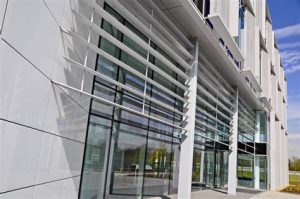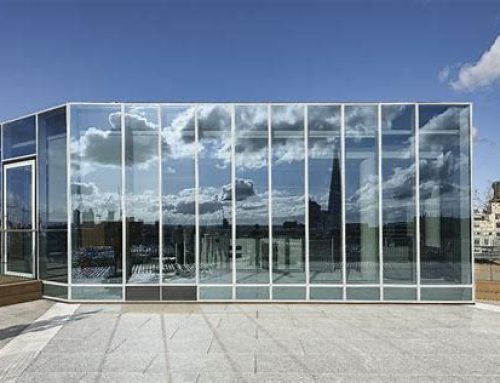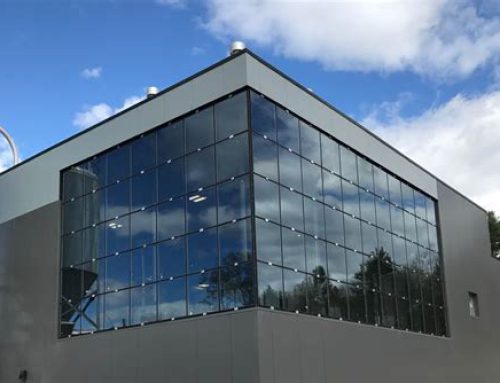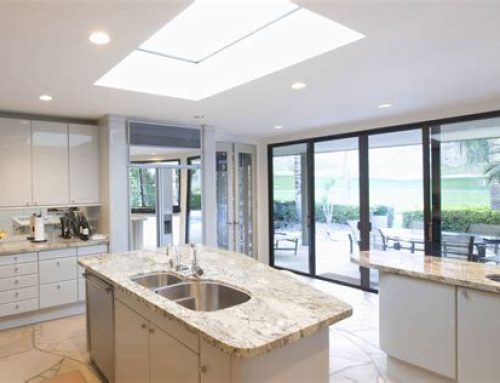Movable aluminum louvre façade
Introduction:

In the realm of modern architecture, façades serve not only as aesthetic elements but also as functional components that contribute to energy efficiency, ventilation, and overall comfort within a building. Among the myriad options available, movable aluminum louvre façades stand out for their versatility and practicality. Combining sleek design with functionality, these innovative systems offer architects and building owners a range of benefits that enhance both the aesthetic appeal and performance of structures.
What Are Movable Aluminum Louvre Façades?
Movable aluminum louvre façades consist of adjustable panels made from lightweight aluminum. These panels are typically arranged horizontally or vertically and can be manipulated to control the amount of sunlight, ventilation, and privacy entering a building. The louvres, or slats, can be rotated or tilted to various angles, allowing for precise regulation of light and airflow. This flexibility makes them an ideal choice for buildings where adaptability and environmental considerations are paramount.
Benefits of Movable Aluminum Louvre Façades:
- Temperature Regulation: One of the primary advantages of movable aluminum louvre façades is their ability to regulate internal temperatures. By adjusting the angle of the louvres, occupants can minimize solar heat gain during hot weather while still allowing natural light to enter the building. Conversely, in colder conditions, the louvres can be positioned to maximize solar heat gain, reducing reliance on artificial heating systems.
- Daylighting: Natural light has numerous benefits, including improved mood, productivity, and energy savings. Movable aluminum louvre façades enable precise control over daylight penetration, allowing occupants to optimize illumination levels throughout the day. By strategically positioning the louvres, glare can be minimized, and daylight can be evenly distributed, reducing the need for artificial lighting and enhancing the visual comfort of indoor spaces.
- Privacy and Security: Privacy is a crucial consideration in many architectural projects. Movable aluminum louvre façades offer a customizable solution, allowing occupants to adjust the angle of the louvres to control visibility from the exterior. Additionally, when fully closed, these systems provide an added layer of security, deterring unauthorized access while maintaining a visually appealing façade.
- Ventilation and Air Quality: Adequate ventilation is essential for maintaining indoor air quality and occupant comfort. Movable aluminum louvre façades facilitate natural ventilation by allowing fresh air to flow freely into the building when desired. By adjusting the angle of the louvres, occupants can optimize airflow while minimizing the ingress of dust, pollen, and pollutants, creating a healthier indoor environment.
- Architectural Versatility: From office buildings to residential complexes, movable aluminum louvre façades can be tailored to suit a variety of architectural styles and design preferences. Available in a range of finishes, colors, and configurations, these systems offer architects and designers the freedom to create visually striking facades that complement the overall aesthetic of the building.
Case Study:
The Louvre Abu Dhabi One notable example of the application of movable aluminum louvre façades is the Louvre Abu Dhabi. Designed by architect Jean Nouvel, this iconic museum features a striking dome structure adorned with a complex pattern of movable aluminum louvres. Inspired by traditional Arabic architecture, the intricate design allows sunlight to filter through while preventing excessive heat gain, creating a mesmerizing interplay of light and shadow within the museum’s interior spaces.
- Smart Integration: Integrating movable aluminum louvre façades with smart building systems allows for seamless control and automation. Sensors can monitor environmental conditions such as temperature, sunlight, and air quality, enabling the louvres to adjust automatically in response to changing factors. This level of integration enhances energy efficiency and occupant comfort while reducing the need for manual intervention.
- Sustainable Materials: The use of sustainable materials in façade construction is a growing trend driven by environmental concerns and regulatory requirements. Manufacturers are exploring eco-friendly alternatives to traditional aluminum, such as recycled or recyclable materials, to reduce the carbon footprint of movable louvre systems. Additionally, innovations in coatings and finishes are improving durability and resistance to corrosion, prolonging the lifespan of façade components.
- Dynamic Designs: As architects push the boundaries of creativity, movable aluminum louvre façades are evolving beyond traditional static configurations. Dynamic designs incorporating kinetic elements, curved surfaces, and asymmetrical patterns are becoming increasingly prevalent, adding a sense of movement and fluidity to building exteriors. These innovative designs not only enhance visual appeal but also offer unique opportunities for environmental responsiveness and user interaction.
- Energy Harvesting: Movable aluminum louvre façades have the potential to contribute to on-site energy generation through integrated photovoltaic (PV) or solar thermal panels. By harnessing solar energy directly from the building envelope, these systems can offset electricity consumption and further enhance the sustainability of the building. Additionally, advancements in energy storage technologies enable excess energy generated during peak sunlight hours to be stored for later use, providing a reliable source of renewable power.
- Urban Integration: Beyond individual buildings, movable aluminum louvre façades are increasingly being incorporated into urban planning strategies to mitigate the heat island effect and improve the overall microclimate of cities. By strategically deploying louvred shading systems on facades at the street level, urban designers can create shaded pedestrian areas and outdoor spaces that offer respite from the sun while encouraging walkability and social interaction. These interventions not only enhance the comfort and livability of urban environments but also contribute to energy savings by reducing the demand for air conditioning.
- Resilience and Adaptability: In an era marked by climate change and unpredictable weather patterns, the ability of buildings to withstand extreme conditions is paramount. Movable aluminum louvre façades offer inherent resilience and adaptability, allowing structures to respond dynamically to changing environmental conditions. Whether shielding against intense sunlight, deflecting strong winds, or providing protection from heavy rainfall, these versatile systems enhance the durability and longevity of buildings, ensuring their continued functionality and performance in the face of evolving challenges.
- Health and Well-being: The importance of indoor environmental quality on occupant health and well-being is increasingly recognized in building design. Movable aluminum louvre façades play a crucial role in promoting a healthy indoor environment by facilitating natural ventilation, maximizing access to daylight, and minimizing exposure to external pollutants. By creating comfortable and visually stimulating spaces, these systems contribute to improved occupant satisfaction, productivity, and overall quality of life, aligning with the growing emphasis on wellness-centered design principles.
- Cultural and Architectural Identity: Beyond their functional attributes, movable aluminum louvre façades have the potential to express cultural heritage and architectural identity. Architects are exploring innovative ways to integrate cultural motifs, patterns, and symbols into louvre designs, creating visually distinctive facades that resonate with local communities and traditions. By blending modern technology with cultural references, these façades become not just functional elements but also powerful symbols of identity and place-making, enriching the built environment with layers of meaning and significance.
Further Advancements and Future Trends:
Conclusion:
Movable aluminum louvre façades have emerged as a versatile and indispensable element in contemporary architecture, offering a harmonious blend of form, function, and sustainability. As urban populations grow and environmental pressures intensify, the demand for innovative building solutions that prioritize efficiency, adaptability, and human well-being will only continue to rise. With their ability to regulate light, temperature, and airflow while enhancing visual appeal and cultural significance, movable aluminum louvre façades are poised to play a central role in shaping the future of urban landscapes, contributing to resilient, healthy, and vibrant cities for generations to come.





Leave A Comment